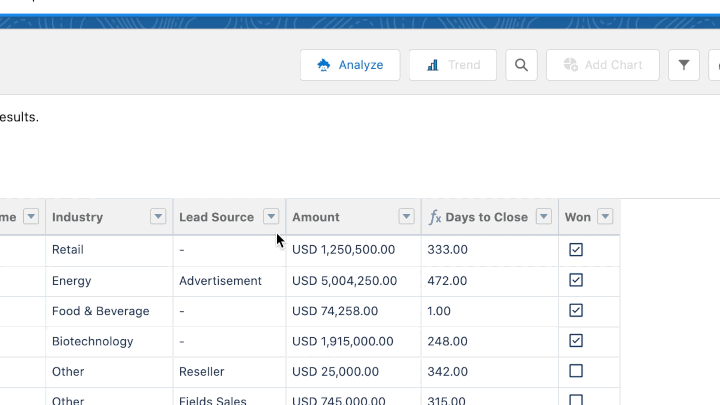Introducing Einstein Discovery for Reports
What are the key drivers of my business goals? How might these change over time? How can I get the most out of Salesforce Reports?

Einstein Discovery for Reports is the answer! With Einstein Discovery for Reports, previously known as Einstein Data Insights, you can quickly unravel hidden insights within your Salesforce Reports and identify key factors that can help drive your business more efficiently.
What is Einstein Discovery?
Einstein Discovery allows users to explore patterns, trends, and correlations in business data using clicks not code. That’s not all, Einstein Discovery is also known for its Machine Learning capabilities powering organizations with embedded AI. Learn more about Einstein Discovery here.
What can you do with the Einstein Discovery for Reports?
- Understand the frequency of Occurrences of values in your Report Data [Example: “How often does a particular region (AMER) show up in my opportunities?”]
- Analyze business goals and understand how columns in your Report Data are impacting them. [Example: “I want to maximize my Profits/Revenues”]
- How did my data change over time to affect my Business goals [Example: “Why did my Win Rate drop 10% since last month?”]
Let’s start off with a normal Salesforce Report

About the Report:
- Report Type: Opportunity with Accounts
- Filters:
Opportunity.isClosed = True & Opportunity.CloseDate = Last Quarter
Occurrences Analysis

The first time you click on the “Analyze” button on any report, Einstein Discovery will perform an Occurrence Analysis, which is a second-order statistical analysis and provides useful insights based on how columns are interacting with one another.
Let’s look into the insights in detail

First Order Insights Card — Exploratory Insights about a specific column in the report.
For the Column Won in my report, the value False occurred more often than True. So it seems like I am losing more opportunities.
Column: Won
False[73.7%], True[26.3%]

Second-Order Insights Card —Exploratory Insights for interactions between a column and a specific value of a different column. “Occurrences of Stage when Region is AMER”
This insight will be a combination of two columns, Won and Lead Source. Specifically when the Lead Source is of value Field Sales.
When Lead Source is Field Sales
Column: Won
False[82%], True[18%]
Note: While overall 73.7% of the deals were lost, when we focus on a specific Lead Source: Field Sales stands out with 82% of deals being lost.
General Questions that can be answered by Occurrences Analysis
- What is the rate of occurrence of the column values in Lead Source?
- When Lead Source is of some value, what is the rate of occurrence of Amount?
- How different is my rate of occurrence of a column value compared to the average?
- How different is the rate of occurrence of a column value compared to every other column value in the same category?
- …
Within a couple of clicks, I can delve into details about my report data and try to understand how my opportunities performed. Further, I could use the powerful search insights bar to pinpoint insights about a specific column or a combination.
Business Goal Analysis

From the Occurrences Analysis, I understand that the Win rate for my Opportunities is around 26.3%. For my Business Goal, I would like to understand what are the important factors that can allow me to Maximize my Win Rate. By defining the goal a regression analysis is kicked off.
Note: Einstein Discovery can work for both Binary and Measure Fields. For example: {Amount, isClosed, isWon, Profit.. etc}
Let’s look into the insights in detail

As soon as the analysis is complete we see a screen with three main components.
- Overview Panel — Provides an overview of the Outcome chosen. Usually is the Average of the Numeric Outcome or Rate of Occurrence for Binary Outcome. Additionally, this panel will also include the rate of change in the outcome over time.
- Correlation Panel — Gives you information about the most impactful columns for the chosen outcome. This is populated by calculating the R² for each of the columns.
- Sorted Insights — Insights are sorted based on the column’s impact on outcome and their relevance. As you can see from the screenshot above, the first few insights are related to the Amount since it has the highest correlation.

The first order insight provided me information that the Amount column has the highest impact for me to Win my Opportunities. In this case, I can see that my organization is performing well for smaller deals and performing spectacularly well for the largest deals. This can be caused because the focus of the organization might be on maximizing Amount among others.

Similar to the Occurrences Second-Order Insights Card, I will get insights for a combination of two columns. In this case, the insights are about how the Win Rate is spread across Lead Source When the Amount is between 0–5,587. In Layman’s terms, Which Lead Source is winning more opportunities for smaller deals?.
General Questions that can be answered by Business Goal Analysis
- What columns are driving my Business Goals?
- How much impact do they have on my set Goals?
- What are the low-performing categories in my columns that are impacting my Business?
- ….
With less than three clicks, I can conduct a regression analysis that can provide me information about my data and how it’s affecting my Goals. Investigate details into your data easily and consume Salesforce Reports like never before with EDR.
What Changed?

My favorite feature on Einstein Discovery for Reports. In this instance, I have my Business Goal defined and I realized that new data has been entered. I can simply click on the refresh button for me to create a new version of the analysis and automatically run a What Changed? Analysis.
What’s In What Changed? Analysis?

A modal with a comparison between the current version of the analysis and a previous version of the analysis is displayed.
General Questions that can be answered by What Changed? analysis

- How did the impact of the columns on my outcome change over time?

- How did the data change across all the columns and were there any significant changes in their impact on the outcome?

- Are there any new values added or are missing from the recent data refresh?
- ….
The goal of What Changed? analysis is to provide easy-to-consume trend insights. With this analysis, one can easily understand how their report data has changed over time and is impacting the defined business goals within the analyses.
Not only that, we have amazing other features that can allow you to easily traverse through the insights, filter on the insights, and overall embellish your experience with Salesforce Reports.
Considerations
Here are some general Considerations while using Einstein Discovery for Reports:
- Limits: Columns [Minimum of 2 and a Maximum of 50]
- Limits: Rows [Minimum of 50 and a Maximum of 500,000]
- Avoid using report columns that contain unique ID columns, data with high cardinality (over 100 unique values), and data with high correlations (greater than 90%) to the selected analytical outcome.
- Exclude rows that haven’t yet reached an outcome. For example, use closed opportunities or cases only.
- Find out more Tips: Here
Helpful Resources
Documentation for Einstein Discovery for Reports
Trailhead for Einstein Discovery for Reports
Release Readiness Summer ‘21
One final request, if you do have any feedback for Einstein Discovery for Reports or Einstein Discovery in general, I would love to hear from you. Please feel free to reach out to me on LinkedIn.









